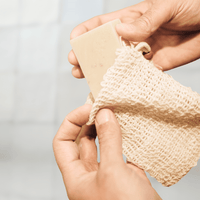
Some people think that going green is difficult, but we want to prove to you that it doesn't have to be!
Many people assume that creating a more "eco-friendly" home has to do with purchasing solar panels or reframing your home with more sustainable materials. Granted, those are great decisions to consider down the line, although there are changes you can make today that don't require massive upfront investments on your end. These small changes can play a huge role on you and your health, and you'll thank yourself later when you realize the positive impact these changes have on your children and fur babies as well.
Lo and behold — our list of Six Simple Ways to Make Your Home More Eco-Friendly:
source: Urban Jungle Bloggers
1. Bring the Outdoors Into your Home
Since humans spend the majority of their time inside, purifying the air in your home is a necessity. Our homes are infected with toxins from synthetic building materials, paints, pesticides, personal care products, cleaning products and other natural pollutants (mold, fungi, etc.). Entering: House Plants. House plants are the easiest addition you can make to your home that immediately reduces the amount of toxic concentrates in the air. They're also the most adorable decor to add to your home and are currently in style. See our list of The 10 Best House Plants for Removing Air Pollutants.
source: designdeveloprealize.com
2. Shop for Products with Sustainable Materials
Little do we all know that most of the products that fill our households are not green-friendly. Tons of plastics sit in our cabinets and on our walls and synthetic materials and dyes in our carpets pollute our air and end up in landfills forever. Some people may argue that leather and wool are great, although we think there are plenty of other cruelty-free options without the animal exploitation, such as: wood, stone, slate, cotton, bamboo, palm, hemp, linen, burlap, cork and clay (terracotta/ceramic).
Instead of plastic plant bowls? Use ceramic, seagrass or terracotta.
Instead of disposable plastic utensils? Use reusable bamboo ones.
Instead of plastic kitchen plates? Look for wood or slate alternatives.
Instead of plastic toothbrushes? Bamboo toothbrushes.
Instead of cotton balls/pads? Bamboo cotton rounds.
Instead of paper towels? Linen/cotton reusable towels.
Instead of plastic razors? Stainless steel.
Instead of tampons and pads? Menstrual cup or Thinx underwear.
Too much? You get the idea.
source: VPR.net
3. Replace Plastic Wrap & Plastic Ware with Natural Containers
According to Livestrong.com and other sources, the plastics you use in the kitchen could be leaking hazardous materials into your food, causing a variety of medical conditions. BPA and PVC are among the two most common chemicals found in common household products that are considered toxic, causing birth defects, skin conditions, cancer and much more.
Instead of plastic wrap, we recommend using this (non-vegan) beeswax alternative. In our experience, they are easy to use, last for a good amount of time, keep out the bad smell and keep food fresh.
The best vegan alternative to the beeswax food wrap would be the Etee's "Organic Reusable Food Wraps." Similar to the beeswax version, except 100 percent organic and vegan! All you have to do is warm them up in your hands to soften the wax and they easily stick to any bowl or plate. Although you can't put these bad boys in the dishwasher, they're low maintenance to wash (just make sure you wash them in cold water).
Lastly, if you're looking to get rid of those nasty, constantly stained plastic containers, you should consider investing in some glass versions. The glass versions hold up much longer than your plastic ones do, and they can be recycled — unlike most plastics that people use daily. Plus, once you hop on the glass train, any glass jars that pass through your house will soon serve another purpose: dressings, pestos, salsas, you name it!
4. Start Using Your Kitchen Scraps
How does food waste contribute to climate change? Glad you asked. Let me give you a brief, semi-scientific rundown.
Food waste, when disposed of incorrectly, has the ability to produce methane. Methane, if you don't know much about it, is 20x more detrimental to our atmosphere compared to carbon dioxide (from a global warming perspective). When food waste is broken down in an environment WITH oxygen (backyard compost), decomposed items break down naturally and produce small amounts of CO2, which are not considered too detrimental to the environment. Although, when food waste is broken down in an environment without oxygen (landfills), CO2 is converted into methane instead, which is a large contributor to climate change.
The easiest way to reduce our food waste: prevention! Prevention is often the easiest step in the process, so make sure you are only buying what you NEED. This conscious shopping habit, in itself, will help you reduce the waste you create. If you end up having a ton of food left over before a big vacation, seek opportunities to feed the hungry or feed your local farms’ livestock. A lot of times, farmers will seek a broad diet for their animals for a better quality of life.
Second, there is composting. Save up your scraps and put them into your backyard for the soil and microorganisms to thrive. And if you don't have enough land to start composting, seek companies in your town that have local drop-offs or collection services. In 2013, there were over 3,500 composting facilities in the United States alone. So regardless of your location, you always have an option for properly disposing of food scraps.
We've recently gotten into making our own homemade veggie broth, and you should, too! It saves you money and trips to the supermarket and it’s EASY. Don't worry about your house beginning to smell. You can always freeze the scraps as well. It is pretty easy. Check out a great step-by-step for homemade broth here.
If veggie broth isn't your thing, consider making sauces, dressings and pestos. Broccoli and cauliflower stems go great in a pesto, and a great Italian dressing always has some pieces of peppers or carrots floating around. Get creative!
source: www.thedecoist.com
5. Replace Toxic Cleaning Products with More Natural Ones
Isn't it scary to think about what insane chemicals are lurking in our cleaning products, touching our skin and circulating through our bodies every time we breathe? YES.
Studies have shown that people can suffer extreme external conditions (such as skin, eye and hair conditions) as well as long-term acute health issues (such as cancer, respiratory issues and birth defects)!
This information alone is scary. We didn't even mention that these chemicals get absorbed into our land and soil after it goes through our waterways. Some chemicals even go into our water and affect the health of our wildlife. Which, if you eat fish, could end up right back into you!
Some scary chemicals to look out for: Phthalates, Ammonia, Chlorine and Sodium.
If you want to go even more earth-friendly, vinegar and baking soda go a loooong way when used to clean household appliances and other items. Also, I use Dr. Bronner’s Castile Soap on just about EVERYTHING!
Check out homemade recipes online!
source: forksoverknives.com
6. Cut Back on Junk Food
Junk food — the delicious and processed luxury in life that turns you into an addicted, chemical-craving junkie.
"It's all great in moderation!" they said... until you become overweight, battling cravings like a pregnant woman and sink into depression! (I know I’m intense, but bear with me, haha.)
These are all potential bodily effects of eating junk food. This type of food is also the most processed, stricken with man-made ingredients that you cannot read all while catalyzing the American "throw-away" culture. Listen to your body and your planet.
Whole foods are better for your mental health, physical health and the environment. This switch has given me more energy than ever! Whole foods rarely come in plastic packages and, if they do, can typically be avoided. Check out local farmers markets or bulk stores!
Eat less from a BOX and more from the EARTH!
More Ways to Make Your Home Eco-Friendly
Perhaps you’ve already made the switch to bamboo toothbrushes, reusable cotton rounds and other zero waste products for the home. Great job!
Now, it’s time to take your sustainability to the next level. Here are a few additional ways you can green up your home, reduce your carbon footprint and live in harmony with Mother Earth.
Swap in some LED bulbs. Incandescent light bulbs may come with a cheap price tag, but they’ll cost you and the environment in the long run. Instead, opt for light-emitting diode (LED) light bulbs, which use less energy and have a much longer lifespan (20 years on average).
Line-dry whenever possible. Why dry your clothes in a machine when the sun and wind will do it for free? On top of saving money and energy, line-drying is usually much easier on your clothes. Plus, you get that wonderful, fresh smell that only comes from the great outdoors!
Opt for energy-saving appliances. Are you in the market for a refrigerator or washing machine? If so, look for energy-efficient appliances with the Energy Star logo. Energy Star appliances use anywhere from 10 to 50 percent less energy than their non-energy efficient counterparts — a win-win for your wallet and the planet.
Get smart about your thermostat. According to Energy.gov, lowering your thermostat by seven to 10 degrees Fahrenheit for eight hours a day can help you save as much as 10 percent annually on heating and cooling. This task is made even easier when you have a programmable thermostat or a smart thermostat that does all the thinking for you.
Install a low-flow shower head. Did you know that showering accounts for nearly 17 percent of indoor water use? For the average family, that’s 40 gallons of water per day! Luckily, low-flow shower heads exist, allowing you to reduce your water consumption and, in turn, save money on your utility bills.
Turn down your water heater. Although 120 degrees Fahrenheit is the recommended temperature for water heater thermostats, some manufacturers set them at 140 degrees (the default setting).
Set up a recycle bin in the bathroom. You may already have a recycling bin for your kitchen — but what about the bathroom? Empty lotion bottles, makeup products and cardboard packaging are just a few of the many bathroom items that can be recycled, and doing so helps keep said items out of a landfill. Pro tip: You can reduce the number of bathroom products you need to recycle by switching to plastic-free shampoo and conditioner bars.
See? Going green in your home doesn’t need to eat up all your time and money! Start by making a few small changes from the list above and you’ll be well on your way to creating a happier, more sustainable home!











